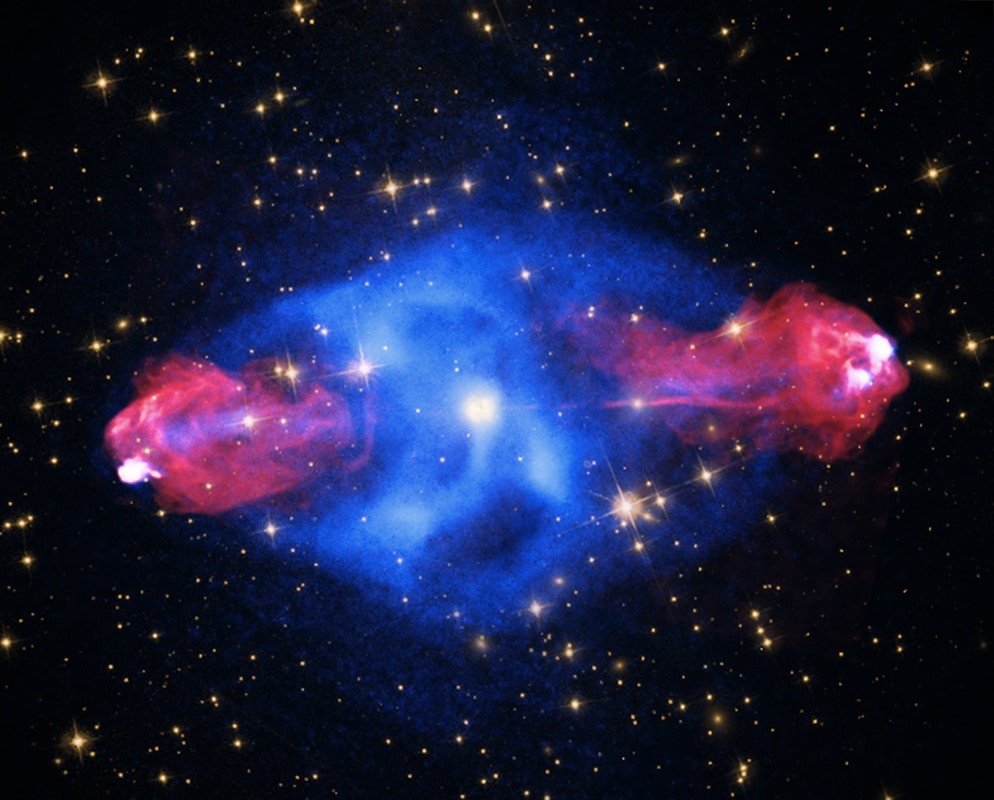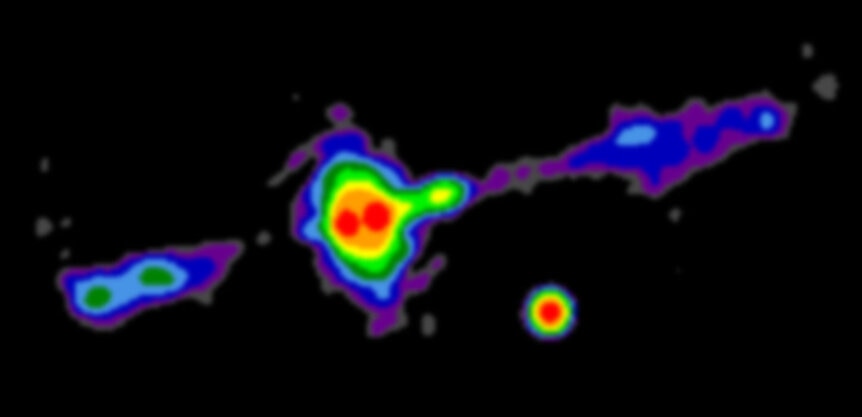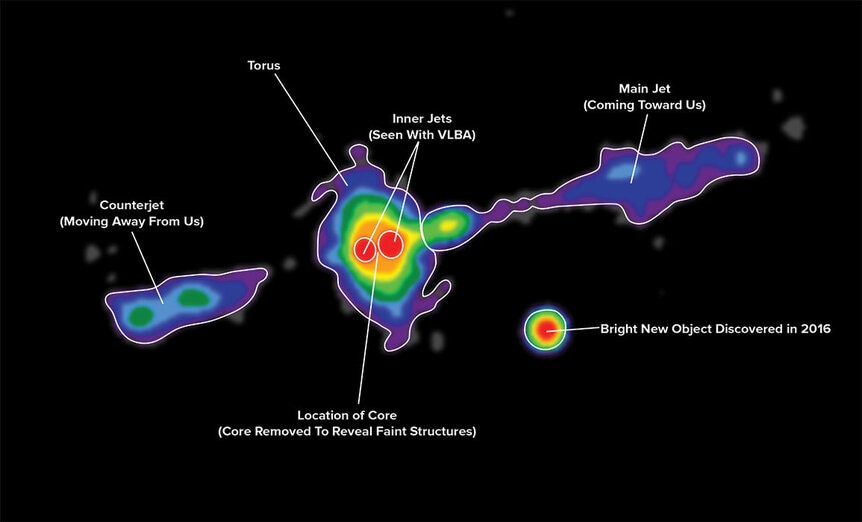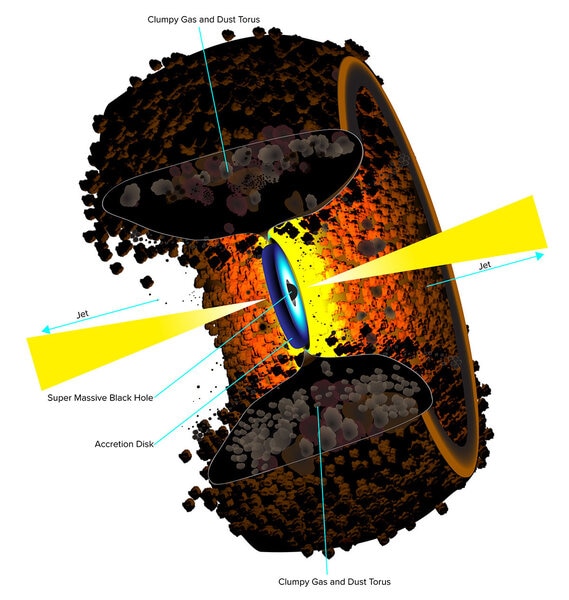Create a free profile to get unlimited access to exclusive videos, sweepstakes, and more!
Astronomers spot a massive doughnut of material around quasar Cygnus A’s supermassive black hole

It’s rare that I see an astronomical image and get a chill running up my neck. But I just saw one that did just that: It shows an immense structure in the center of a galaxy that has never been seen before in this particular kind of galaxy. And it shows (once again) that a scientific model astronomers dreamed up years ago to describe hugely powerful galaxies is correct.
The galaxy is called Cygnus A. The name means it’s the brightest source of radio waves in the constellation Cygnus, and in fact is so strong that it was discovered in 1939, not long after the birth of radio astronomy, despite being a staggering 600 million light years away. It’s the first radio source in the sky to have been identified as a galaxy, too (not counting our own, to be pedantic), so it already has a solid place in astronomical history.
It’s what we call an active galaxy, which means that it has an unusual amount of energy coming from its core. Most spiral galaxies have lots of stars and such in their centers, so they appear relatively bright. But a fraction of them are really bright, and in some cases their cores can outshine all the rest of the light from the galaxy combined.
These active galaxies come in many flavors. Some of them pour out radio waves, yet not much optical light (the kind we see). Some are intensely bright in X-rays, and a small fraction even blast out gamma rays, the highest-energy form of light there is. It takes a whopping powerful engine to generate gamma rays, and we now know what that is: a supermassive black hole.
Every big galaxy has one at its heart, but in active galaxies the black hole is actively feeding, gobbling down matter. This material falls in to the galactic center and piles up around the black hole in what’s called an accretion disk, which in the inner region whips around the hole near the speed of light. The friction generated is immense, and heats the material up to ridiculously high temperatures. The spinning material also makes powerful magnetic fields, which wind up like tornadoes above and below the disk. Material can be ripped away from the disk by those fields, focused into thin beams, and launched into space at speeds just below the speed of light as well. We call those beams jets.
Cygnus A is famous for its jets, which reach distances of hundreds of thousands of light years before slowing down and puffing up as they slam into material outside the galaxy.
But a new observation, taken using the Very Large Array in radio waves, shows a feature at the very heart of Cygnus A that plays a huge role in how we see active galaxies. Here’s the image:
This shows the center of Cygnus A, covering an area about 5,000 light years across or so. The jets are obvious as linear features stretching across, and the extremely bright nucleus has been subtracted so you can see details in the center. And that’s where the payoff is. The two bright red spots are the inner jets, a few hundred light years long … and surrounding them is a circular feature (seen at an angle so it looks like an ellipse): That’s a dust torus, a doughnut-shaped structure, and that’s the big news here.
This feature is colossal, about 1,300 light years across, with a mass of several hundred million times the mass of the Sun, and is made of countless clouds of dust (small grains of silicates and carbon) swirling around the black hole in the center, and much farther out than the hot accretion disk. The dust is so thick it’s completely opaque to visible light, and it’s the key to the active galaxy zoo across the sky.
How? Because it’s so big, thick, and opaque, it changes how we see a galaxy’s core. If the torus is seen edge on from Earth, then it blocks all the visible light, as well as higher-energy ultraviolet, X-rays, and gamma rays. We may see the tremendously long jets using radio telescopes, but other telescopes don’t see much. We call those radio galaxies.
If it’s tilted, like with Cygnus A, we can see closer in to the black hole — we’re peeking over the edge of the torus, and some of the higher-energy light gets to us. These are called Seyfert galaxies (after the astronomer who first classified them, Carl Seyfert), and sometimes quasars, depending on details of what’s seen.
And sometimes we’re looking right down the axis of the black hole, straight down the jets. In that case the highest-energy light, gamma rays, gets to us, and we call those active galaxies blazars.
For a long time the connection between these various active galaxies wasn’t known. Then in the late 20th century astronomers started thinking there was a torus of dust blocking our view in some of them, and the angle at which we saw them determined what we saw. This is called the unified model of active galaxies, and has become the standard model astronomers use today. There are some exceptions to it, but for most active galaxies we know that the dust torus dominates what we see.
And now we can see a torus! There has been evidence of them in fainter active galaxies, but this is the first time one has been seen, and so clearly, in a really bright one. Cygnus A also happens to be close as these things go, so we have a pretty good view of it. Incidentally, the bright object to the right of the center in the VLA image is another supermassive black hole, almost certainly left over from another galaxy Cygnus A ate some millions of years ago. So really, there’s nothing not cool about this observation.
I’ll note that the black hole in the center of the Milky Way is what we call quiescent, which means not emitting energy. It’s almost certain that billions of years ago it was active, and may have been much more recently, but right now it’s just kinda sitting there. That doesn’t mean it’ll always be that way; there are dust clouds and such orbiting it, and if they get too close, it too could be active briefly once again. The good news is that we think it’s pointed away from us, so it shouldn’t be a problem to our greatnth descendants.
But that doesn’t make it any less interesting. Studying other galaxies like Cygnus A teaches us about ours, just as understanding ours teaches us about the Universe at large. These are all puzzle pieces that fit together — into a unified picture, you might say — and science is the set of rules we’ve figured out to see how that works.






























